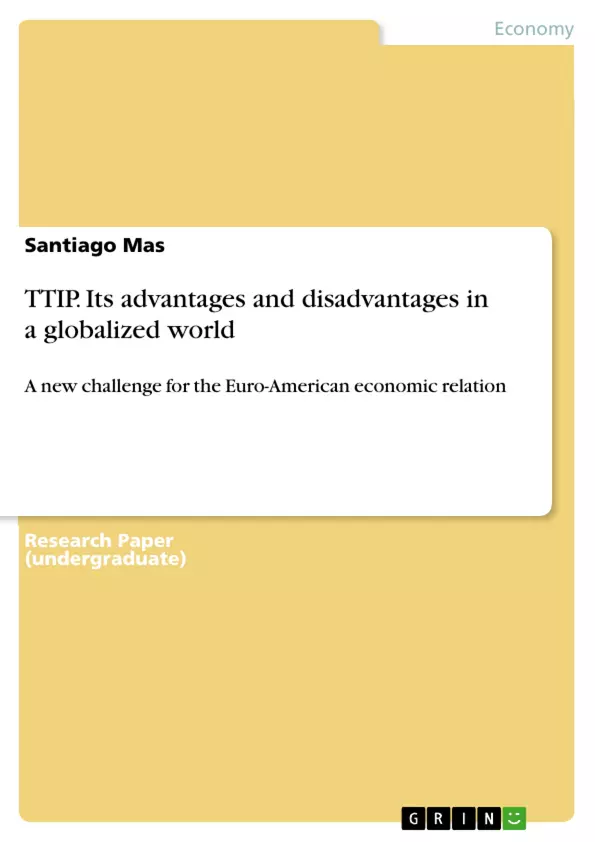The Transatlantic Trade and Investment Partnership (hereinafter TTIP) is a bilateral free trade agreement affecting the EU and the USA and its goal is to remove tariff, non-tariff barriers and legal processes as well as trade regulations to facilitate and intensify the exchange of goods, services and investment between the two partners. Negotiations started on the 8th of July 2013 in Washington and still go on, as many details, regulations and sectors involved have not been definitely agreed yet. The debate remains, especially in the US, at the governmental level, as most of the US citizens do not even know of its existence. However, in the EU member states, the debate has been on the media for a while now with both, defenders and detractors, using a myriad of economic estimates and scenarios supporting their respective arguments.
If other forms or superregional trade integration forms –with different characteristics and degrees of economic integration- have already been in place in the world since many years ago, the economic size and global influence of the two candidates willing to subscribe this free trade agreement make the TTIP a decisive macro economic zone accounting for approximately 30% of global goods trade, about 40% of the world services, and nearly half of the global GDP.
Inhaltsverzeichnis (Table of Contents)
- INTRODUCTION
- OBJECTIVES
- US & EU. SOME KEY FIGURES ON THEIR MUTUAL TRADE RELATION
- INSIGHTS ON THE ECONOMIC FRAMEWORK AND THE NEED FOR TTIP
- DEGREES OF ECONOMIC INTEGRATION
- ADVANTAGES AND BENEFITS OF TTIP
- For the EU
- For the US
- DISADVANTAGES AND RISKS
- For the EU
- For the US
- CONCLUSION
Zielsetzung und Themenschwerpunkte (Objectives and Key Themes)
This assignment aims to analyze and critically discuss the necessity of the Transatlantic Trade and Investment Partnership (TTIP), its current framework, goals, and advantages and disadvantages from both European and American perspectives within a globalized world. By exploring the agreement and its clauses beyond official statements, the assignment aims to provide readers with objective elements of judgment, enabling them to form their own opinion about the suitability and potential success of TTIP.
- The need for a free trade agreement (FTA) between the EU and the US
- The economic framework and the role of TTIP
- Advantages and benefits of TTIP for both the EU and the US
- Disadvantages and risks of TTIP for both the EU and the US
- The impact of TTIP on the globalized world
Zusammenfassung der Kapitel (Chapter Summaries)
The introduction provides a background on the Transatlantic Trade and Investment Partnership (TTIP), a bilateral free trade agreement between the EU and the USA aimed at eliminating tariffs, non-tariff barriers, and legal processes to facilitate trade and investment. The agreement's negotiations started in 2013 and are still ongoing. The introduction also emphasizes the economic significance of TTIP, considering the combined size and influence of the EU and US economies.
The objectives chapter outlines the main goal of the assignment, which is to analyze and critically discuss the need for TTIP, its framework, goals, and advantages and disadvantages from both European and American perspectives within a globalized world. It highlights the assignment's aim to provide readers with objective information to form their own opinions about TTIP.
Chapter 3 focuses on key figures and data related to the US and EU economies, highlighting their similarities in GDP (PPP), size, and development levels. The chapter also emphasizes their common values and views on trade regulation, political systems, and economic liberalization, making them complementary economies that could mutually benefit from greater economic integration.
Chapter 4 explores the economic framework and the need for TTIP, emphasizing the potential market created by unified standards and regulations, which would offer over 800 million consumers with high incomes and developed consumption habits to both American and European companies.
Chapter 5 discusses different degrees of economic integration, providing context for understanding the potential impact of TTIP on the existing economic integration models around the world.
Chapter 6 focuses on the advantages and benefits of TTIP, exploring the potential gains for both the EU and the US economies. The chapter highlights the positive aspects of increased trade, investment, and economic growth that TTIP could bring.
Schlüsselwörter (Keywords)
The main keywords and focus topics of this assignment are: Transatlantic Trade and Investment Partnership (TTIP), Free Trade Agreement (FTA), EU, US, economic integration, trade liberalization, tariffs, non-tariff barriers, economic growth, globalized world, advantages, disadvantages, risks.
- Quote paper
- Santiago Mas (Author), 2016, TTIP. Its advantages and disadvantages in a globalized world, Munich, GRIN Verlag, https://www.grin.com/document/437670



